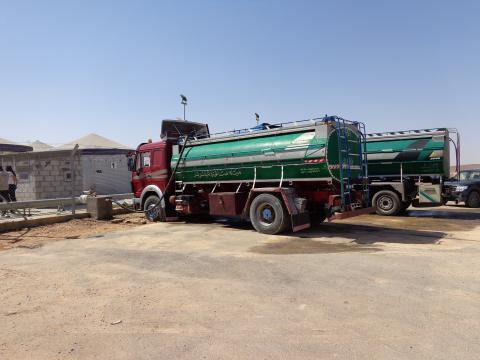Water Means Life

In some of the world’s harshest conditions, World Vision is helping to bring water to Syrian refugees at Jordan’s Azraq refugee camp.
In any humanitarian relief situation, the first priorities for aid agencies like World Vision are to provide people with basic services, such as food, water and shelter. But in an area where the annual rainfall level would barely fill half a coffee cup (220 millilitres), providing refugees with adequate water supplies for drinking, cooking, washing and personal hygiene is a daunting challenge.
World Vision has been given the task of supplying water to up to 30,000 Syrian refugees in the first phase of the opening of the Azraq camp, located about 100 kilometres east of the Jordanian capital of Amman.
To do this, the agency has worked with local partners and other NGOs to construct eight large water tanks, each capable of holding approximately 95,000 litres of water, which is trucked in from nearby water sources. More than 12 kilometres of pipelines have been laid to bring water from these tanks to 156 taps, which means no refugee family will be more than 250 meters away from a water source. The result, according to Margarettha Siregerar, who is coordinating World Vision’s water and sanitation systems at Azraq, is that each refugee should be able to access at least 30 litres of water per day to meet their personal needs.
That sounds like a lot, but as Sireregar points out, the average North American uses between 300 to 400 litres of water per day for their personal needs. Add to that the harsh climate at Azraq, where temperatures regularly pass the 40-degree Celsius mark (104 degrees Fahrenheit) during the summer months.
Sireregar acknowledges that refugees are going to face a big adjustment in terms of access to water. She points out that rainfall levels are higher in Syria, and most Syrians are used to water on demand and indoor plumbing in their homes, rather than having to share latrines and washing facilities with other families.
Water storage tanks operated and maintained by World Vision at the Azraq Refugee Camp. Each tank holds approximately 95,000 litres of water. Photo by Bob Neufeld
At the same time, efforts are underway to improve the water supply situation. U.S. military personnel, assisted by other non-governmental organisations (NGOs), have begun drilling boreholes outside the camp to locate new supplies of clean water. Water conservation will be crucial to keep supplies at reasonable levels and to reduce the amount that needs to be trucked in each day.
World Vision and other agencies will take part in information campaigns to educate both children and adults within the camp about the need to conserve water.
For Margarettha Sireregar, the chance to work in Jordan at the Azraq Camp represents a unique professional challenge for her. But after four months in Jordan and having seen the plight of Syrian refugee children and their families, there are other motivations as well.
“When you deal with a tsunami or an earthquake, you have the sense that once the event is over, there’s a chance for people to return to their homes and rebuild their lives,” she says. “Here, these people have no idea when the conflict will be over and when they can go home. Helping them, especially the children, to make their lives a little more bearable is what attracted me to this role.”
Here, in this corner of the desert, World Vision is doing what it can to do just that – making life a bit more bearable for thousands of Syrians facing life in a new country.